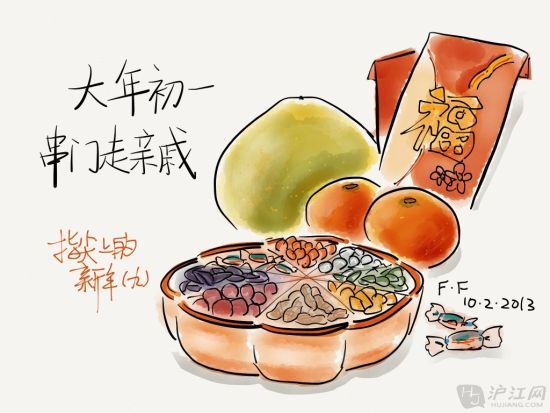春节双语习俗盘点:大年初一串门走亲戚
 大年初一串门走亲戚
大年初一串门走亲戚Chinese New Year on my fingertip
指尖上的新年:大年初一 串门走亲戚
Today is the 1st day of the 1st month in Lunar Calendar。
On the first day, the oldest and most senior members will be visited, the visits serve to strengthen family kinship。
This practice is called 拜年 ( bai nian, or wishing somebody a Happy New Year)。
The visitor will bring a small gift to the household which will be visited- usually two mandarin oranges, as the fruit symbolises gold, hence wealth and good fortune。
Giving oranges in pairs because of the preference of number two in Chinese culture as there is an idiom saying 好事成双 ( hao shi cheng shuang, good things come in pairs)。
Children or unmarried will receive 红包 (hong bao, or red packet) from the senior。
The red colour of the envelope symbolises good luck and is supposed to ward off evil spirits。
It is traditional to put brand new notes inside red packets and also to avoid opening the packets in front of the relatives。
There is also the tradition of welcoming guests with tea and sweet treats, such as sugared fruits which are supposed to sweeten one’s upcoming year。
Sweets and fruits are served on a round tray - the form resembling togetherness and hence the tray is most commonly translated as the “Tray of Togetherness” (八宝盒,ba bao he)。
The sweets will be arranged in eight units, as the number eight symbolises luck as the Chinese word 8 (ba) sounds similar to prosperity (fa, 发)。
In addition, the fruit pomelo is always consumed at Chinese New Year as its Chinese name 柚 (you) sounds exactly same to the word ‘to have’ (有, you) in the language. This fruit signifies abundance in Chinese food symbolism。
(沪江英语)
- 双语:插画家给火车乘客“换头”自娱自乐2015-02-13 09:49
- 双语:生命的十一种感动你拥有了多少(图)2015-02-13 09:34
- 双语健康:研究称学会走路早长大身体好2015-02-12 17:57
- 双语:神奇铅笔让孩子集中精力学习(图)2015-02-12 17:54
- 春节习俗盘点:三十儿晚上熬一宿(双语)2015-02-12 11:03
- 春节序曲:孩子必须知道的小年习俗(双语)2015-02-11 11:36

